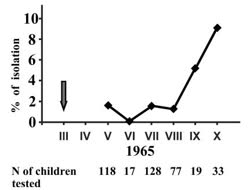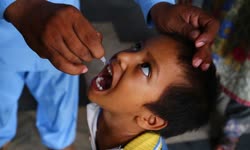|
"widespread circulation and evolution of independent lineages of vaccine-derived polioviruses took place in the region" Korotkova et al 2003 |
|
464 persons became paralysed and, at least 90,000 people were infected with a vaccine strain of polio. The Vaccine Origin of the 1968 Epidemic of Type 3 Poliomyelitis in Poland |
|
"Hager contracted the disease from the vaccine and nearly died" But when his infant son was inoculated against polio with the live-virus Sabin vaccine in August 1973, Hager contracted the disease from the vaccine and nearly died. After four months of hospitalization and rehabilitation, he emerged–without the use of his legs–to a new life. |
|
"patients with vaccine-associated paralytic poliomyelitis." Attenuated strains of the Sabin oral poliovirus vaccine replicate in the human gut and in rare cases cause vaccine-associated paralytic poliomyelitis (VAPP). Reversion of vaccine strains toward a pathogenic phenotype is probably one of the main causes of VAPP, a disease most frequently associated with type 3 and type 2 strains and more rarely with the type 1 (Sabin 1) strain. To identify the determinants and mechanisms of safety versus pathogenicity of the Sabin 1 strain, we characterized the genetic and phenotypic changes in six Sabin 1-derived viruses isolated from immunocompetent patients with VAPP. The genomes of these strains carried either few or numerous mutations from the original Sabin 1 genome. As assessed in transgenic mice carrying the human poliovirus receptor (PVR-Tg mice), all but one strain had lost the attenuated phenotype. Four strains presented only a moderate neurovirulent phenotype, probably due at least in part to reversions to the wild-type genotype, which were detected in the 5' noncoding region of the genome. The reversions found in most strains at nucleotide position 480, are known to be associated with an increase in neurovirulence. The construction and characterization of Sabin 1 mutants implicated a reversion at position 189, found in one strain, in the phenotypic change. The presence of 71 mutations in one neurovirulent strain suggests that a vaccine-derived strain can survive for a long time in humans. Surprisingly, none of the strains analyzed were as neurovirulent to PVR-Tg mice as was the wild-type parent of Sabin 1 (Mahoney) or a previously identified neurovirulent Sabin 1 mutant selected at a high temperature in cultured cells. Thus, in the human gut, the Sabin 1 strain does not necessarily evolve toward the genetic characteristics and high neuropathogenicity of its wild-type parent. |
|
Circulation of Endemic Type 2 Vaccine-Derived Poliovirus in Egypt from 1983 to 1993 Evidence is growing that wild type 2 poliovirus has already been eradicated (7, 72, 73). The last reported human infection with indigenous wild type 2 poliovirus was associated with a poliomyelitis (polio) case in Aligarh, Uttar Pradesh, India, in October 1999 (73). Apart from a recent localized breach in containment of type 2 poliovirus (MEF-1 strain) in northern India (74), the only known current type 2 poliovirus infections are from the oral poliovirus vaccine (OPV) itself. |
|
Spread of Vaccine-Derived Poliovirus from a Paralytic Case in an Immunodeficient Child "The first spreading outbreak of a vaccine-derived strain, in which 22 children were paralyzed, was detected in 2001 in the Dominican Republic and Haiti." - NYT |
|
Reemergence of recombinant vaccine-derived poliovirus outbreak in Madagascar. From May to August 2005, a total of 5 cases of acute flaccid paralysis were reported among unvaccinated or partially vaccinated children 2-3 years old. Type-3 or type-2 VDPV was isolated from case patients and from healthy contacts. These strains were classified into 4 recombinant lineages that showed complex mosaic genomic structures originating from different vaccine strain serotypes and probably from human enterovirus C (HEV-C) species. Genetic relatedness could be observed among these 4 lineages. Vaccination coverage of the population was very low (<50%). |
|
type 1 vaccine-derived poliovirus in the Philippines in 2001 In 2001, highly evolved type 1 circulating vaccine-derived poliovirus (cVDPV) was isolated from three acute flaccid paralysis patients and one contact from three separate communities in the Philippines. Complete genomic sequencing of these four cVDPV isolates revealed that the capsid region was derived from the Sabin 1 vaccine strain but most of the noncapsid region was derived from an unidentified enterovirus unrelated to the oral poliovirus vaccine (OPV) strains. The sequences of the cVDPV isolates were closely related to each other, and the isolates had a common recombination site. Most of the genetic and biological properties of the cVDPV isolates were indistinguishable from those of wild polioviruses. However, the most recently identified cVDPV isolate from a healthy contact retained the temperature sensitivity and partial attenuation phenotypes. The sequence relationships among the isolates and Sabin 1 suggested that cVDPV originated from an OPV dose given in 1998 to 1999 and that cVDPV circulated along a narrow chain of transmission. Type 1 cVDPV was last detected in the Philippines in September 2001, and population immunity to polio was raised by extensive OPV campaigns in late 2001 and early 2002. |
|
Transmission of Imported Vaccine-Derived Poliovirus in an Undervaccinated Community in Minnesota Phylogenetic analysis suggested that the Vacine Derived Polio Virus (VDPV) circulated in the community for roughly 2 months before the infant's infection was detected and that the initiating Oral Polio Vaccine dose had been given before her birth. No paralytic disease was found in the community, and no poliovirus infections were found in other Amish communities investigated.
|
|
315 cases of type 2 circulating vaccine-derived poliovirus occurred during July 2005–June 2010 Wild poliovirus has remained endemic in northern Nigeria because of low coverage achieved in the routine immunization program and in supplementary immunization activities (SIAs). An outbreak of infection involving 315 cases of type 2 circulating vaccine-derived poliovirus (cVDPV2; >1% divergent from Sabin 2) occurred during July 2005–June 2010, a period when 23 of 34 SIAs used monovalent or bivalent oral poliovirus vaccine (OPV) lacking Sabin 2. In addition, 21 “pre-VDPV2” (0.5%–1.0% divergent) cases occurred during this period. Both cVDPV and pre-VDPV cases were clinically indistinguishable from cases due to wild poliovirus. The monthly incidence of cases increased sharply in early 2009, as more children aged without trivalent OPV SIAs. Cumulative state incidence of pre-VDPV2/cVDPV2 was correlated with low childhood immunization against poliovirus type 2 assessed by various means. Strengthened routine immunization programs in countries with suboptimal coverage and balanced use of OPV formulations in SIAs are necessary to minimize risks of VDPV emergence and circulation. |
|
The Cutter Incident: How America's First Polio Vaccine Led to a Growing Vaccine Crisis In April 1955 more than 200 000 children in five Western and mid-Western USA states received a polio vaccine in which the process of inactivating the live virus proved to be defective. Within days there were reports of paralysis and within a month the first mass vaccination programme against polio had to be abandoned. Subsequent investigations revealed that the vaccine, manufactured by the California-based family firm of Cutter Laboratories, had caused 40 000 cases of polio, leaving 200 children with varying degrees of paralysis and killing 10. |
|
DEMOCRATIC REPUBLIC OF CONGO, CIRCULATING VACCINE DERIVED POLIOVIRUS
The last confirmed wild poliovirus (WPV) case in Democratic Republic of Congo (DRC) had paralysis onset in December 2011 (1). DRC has had cases of vaccine-derived polioviruses (VDPVs) documented since 2004.
|
|
NIGER: CIRCULATING VACCINE-DERIVED POLIOVIRUS (CVDPV) Two cases of circulating vaccine-derived poliovirus type 2 (cVDPV2) have been reported from Zinder province, in the south of Niger [1]. The dates of onset of paralysis were 18 July and 8 August, 2018. The cases are genetically linked to a cVDPV2 in Jigawa, northern Nigeria [1]. Surveillance for further cases is being strengthened and an outbreak response will be implemented [2].
|
|
Circulating vaccine-derived poliovirus type 2 – Nigeria On 5 June 2018, a circulating vaccine-derived poliovirus type 2 (cVDPV2) outbreak was confirmed in Sokoto State, Nigeria. From 30 January through 23 May 2018, ten environmental samples collected from two collection sites all tested positive for genetically-related VDPV2 viruses. No associated cases of acute flaccid paralysis (AFP) have been detected with this cVDPV2.
|
|
CIRCULATING VACCINE-DERIVED POLIOVIRUS TYPE 1 CONFIRMED IN PAPUA NEW GUINEA Following identification last month of an acute flaccid paralysis (AFP) case from which vaccine-derived poliovirus type 1 (VDPV1) had been isolated, genetic sequencing of two VDPV1s from two non-household contacts of the AFP case has now confirmed that VDPV1 is circulating and is being officially classified as a ‘circulating’ VDPV type 1 (cVDPV1). |
|
Circulating vaccine-derived poliovirus type 2 – Somalia Circulation of vaccine-derived poliovirus type 2 (cVDPV2) has been confirmed in Somalia. Three cVDPV2s strains were isolated from environmental samples collected on 4 and 11 January 2018, in Banadir province (Mogadishu). These latest isolates are genetically linked to cVDPV2 strains collected from environmental samples in the same province on 22 October and 2 November 2017. |
|
Polio outbreaks in Africa caused by mutation of strain in vaccine The Guardian, Dec 6, 2019. Global Development. Global development is supported by Bill and Melinda Gates Foundation About this content (This website is funded by support provided, in part, by the Bill and Melinda Gates Foundation. The journalism and other content is editorially independent and its purpose is to focus on global development. All our journalism follows GNM’s published editorial code. The Guardian is committed to open journalism, recognising that the best understanding of the world is achieved when we collaborate, share knowledge, encourage debate, welcome challenge and harness the expertise of specialists and their communities.) Edna Mohamed Thu 28 Nov 2019 13.04 GMT Last modified on Thu 28 Nov 2019 15.51 GMT |
|
One child gets polio from a vaccine, infects 11 others and now 12 children are paralyzed for life by one shot of the polio vaccine, for a virus that was already extinct in that country. Government attempted to cover it up. Pakistan accused of cover-up over fresh polio outbreak caused by the vaccine itself.
|
|
The World Health Organization says a new polio outbreak in Sudan is linked to an ongoing vaccine-sparked epidemic in Chad
LONDON -- The World Health Organization says a new polio outbreak in Sudan is linked to an ongoing vaccine-sparked epidemic in Chad — a week after the U.N. health agency declared the African continent free of the wild polio virus.
|

